一、Gin介绍
Gin是一个用Go编写的HTTPweb框架。它是一个类似于martini但拥有更好性能的API框架, 优于httprouter,速度提高了近 40 倍。 点击此处访问Gin官方中文文档。
二、安装
1、安装Gin
go get -u github.com/gin-gonic/gin2、代码中引入
import "github.com/gin-gonic/gin"
3、简单示例,验证
新建文件main.go,内容如下:
package main
import (
"net/http"
"github.com/gin-gonic/gin"
)
func main() {
// 1.创建路由
r := gin.Default()
// 2.绑定路由规则,执行的函数
// gin.Context,封装了request和response
r.GET("/", func(c *gin.Context) {
c.String(http.StatusOK, "hello World!")
})
// 3.监听端口,默认在8080
// Run("")里面不指定端口号默认为8080
r.Run(":8000")
}
运行后访问: http://localhost:8000/
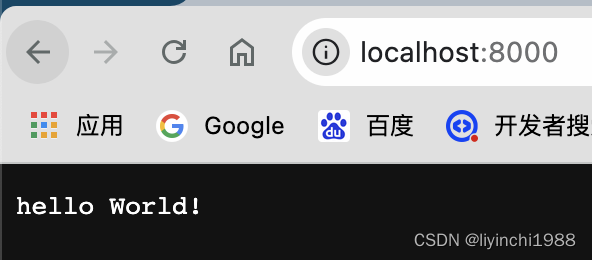
三、渲染前端与配置跨域
1、渲染html模板
Gin支持加载HTML模板, 然后根据模板参数进行配置并返回相应的数据,本质上就是字符串替换。LoadHTMLGlob()方法可以加载模板文件(参数为待渲染的html模板文件,如果参数为相对路径则为运行路径的相对路径)。
a、 渲染单个文件
r.LoadHTMLGlob("web/index.html")
b、 渲染文件夹下的所有文件
r.LoadHTMLGlob("web/*")
c、 渲染文件夹下的所有html后缀的文件
比如:
r.LoadHTMLGlob("web/*.html")
2、定义模板分割
r.Delims("<<<", ">>>")第一个参数为:模板标签开始标记
第二个参数为:模板标签结束标记
3、渲染静态文件和目录
如果你需要引入静态文件需要定义一个静态文件目录
r.Static("/assets", "./static/assets")
若assets的目录结构为

可以根据 http://localhost:8000/assets/img/home.jpg 访问指定资源

如果r为路由组,则需要在assets前拼接路由组的路径包括其前缀
4、重定向
// 重定向两种默认应支持的首页访问方式
router.GET("/", func(c *gin.Context) {
//重定向到/index.html
c.Redirect(302, "/index.html")
})
router.GET("/index", func(c *gin.Context) {
//重定向到/index.html
c.Redirect(302, "/index.html")
})
router.GET("/index.html", func(c *gin.Context) {
//返回渲染的html模板中的index.html
c.HTML(http.StatusOK, "index.html", gin.H{
"baseUrl": "http://" + host,
})
})
5、配置跨域
Next()
r.Use(Next())允许跨域
// 允许跨域
func Next() gin.HandlerFunc {
return func(c *gin.Context) {
method := c.Request.Method
c.Header("Access-Control-Allow-Origin", "*")
c.Header("Access-Control-Allow-Headers", "Access-Control-Allow-Headers,Authorization,User-Agent, Keep-Alive, Content-Type, X-Requested-With,X-CSRF-Token,AccessToken,Token")
c.Header("Access-Control-Allow-Methods", "GET, POST, DELETE, PUT, PATCH, OPTIONS")
c.Header("Access-Control-Expose-Headers", "Content-Length, Access-Control-Allow-Origin, Access-Control-Allow-Headers, Content-Type")
c.Header("Access-Control-Allow-Credentials", "true")
// 放行所有OPTIONS方法
if method == "OPTIONS" {
c.AbortWithStatus(http.StatusAccepted)
}
c.Next()
}
}
6、响应格式 c.String() c.JSON() c.JSONP() c.XML() c.HTML()
(1)返回一个字符串
r.GET("/news", func(c *gin.Context) {
aid := c.Query("aid")
c.String(200, "aid=%s", aid)
})
(2)返回一个 JSON 数据
//方法一:自己拼接JSON
r.GET("/json", func(c *gin.Context) {
//返回json数据,使用 map[string]interface
//c.JSON(返回的状态码, 任意类型的数据(如:map,struct,...)
c.JSON(200, map[string]interface{}{
"success": true,
"msg": "你好",
})
})
//方法二:gin中的H函数
r.GET("/json2", func(c *gin.Context) {
//返回json数据,使用gin中的H函数, gin.H 是 map[string]interface{}的缩写
c.JSON(200, gin.H{
"success": true,
"msg": "你好gin",
})
})
//方法三:使用结构体
r.GET("/json3", func(c *gin.Context) {
//实例化一个结构体
a := &Article{
Title: "标题",
Desc: "说明",
Content: "内容",
}
c.JSON(200, a)
})JSOPN: jsonp请求 主要用来解决跨域问题
//jsonp请求 主要用来解决跨域问题
//http://127.0.0.1:8080/jsonp?callback=call
//call({"title":"标题-jsonp","desc":"说明-jsonp","content":"内容-jsonp"});
r.GET("/jsonp", func(c *gin.Context) {
//实例化一个结构体
a := &Article{
Title: "标题-jsonp",
Desc: "说明-jsonp",
Content: "内容-jsonp",
}
c.JSONP(200, a)
})
(3)返回 XML 数据
//方法一:使用gin.H返回
r.GET("/xml", func(c *gin.Context) {
c.XML(http.StatusOK, gin.H{
"success": true,
"msg": "成功xml",
})
})
//方法二:使用结构体
r.GET("/xmlStruct", func(c *gin.Context) {
//实例化一个结构体
a := &Article{
Title: "标题-xmlStruct",
Desc: "说明-xmlStruct",
Content: "内容-xmlStruct",
}
c.XML(200, a)
})(4)返回HTML数据
//初始化路由
r := gin.Default()
//加载templates文件中所有模板文件,以便后续c.HTML()渲染文件时使用
r.LoadHTMLGlob("templates/*")
r.GET("/news", func(c *gin.Context) {
//使用模板文件渲染HTML文件
//前提: r.LoadHTMLGlob("templates/*")
//HTML(状态码, 要渲染的文件名, 加载的参数)
c.HTML(http.StatusOK, "news.html", gin.H{
"title": "我是一个news",
})
})
完整代码案例如下:
package main
import (
"github.com/gin-gonic/gin"
"net/http"
)
type Article struct {
Title string `json:"title"`
Desc string `json:"desc"`
Content string `json:"content"`
}
func main() {
//初始化路由
r := gin.Default()
//加载templates文件中所有模板文件,以便后续c.HTML()渲染文件时使用
r.LoadHTMLGlob("templates/*")
//配置路由
r.GET("/", func(c *gin.Context) {
c.String(200, "首页")
})
r.GET("/json", func(c *gin.Context) {
//返回json数据,使用 map[string]interface
//c.JSON(返回的状态码, 任意类型的数据(如:map,struct,...)
c.JSON(200, map[string]interface{}{
"success": true,
"msg": "你好",
})
})
r.GET("/json2", func(c *gin.Context) {
//返回json数据,使用gin中的H函数
c.JSON(200, gin.H{
"success": true,
"msg": "你好gin",
})
})
r.GET("/json3", func(c *gin.Context) {
//实例化一个结构体
a := &Article{
Title: "标题",
Desc: "说明",
Content: "内容",
}
c.JSON(200, a)
})
//jsonp请求 主要用来解决跨域问题
//http://127.0.0.1:8080/jsonp?callback=call
//call({"title":"标题-jsonp","desc":"说明-jsonp","content":"内容-jsonp"});
r.GET("/jsonp", func(c *gin.Context) {
//实例化一个结构体
a := &Article{
Title: "标题-jsonp",
Desc: "说明-jsonp",
Content: "内容-jsonp",
}
c.JSONP(200, a)
})
r.GET("/xml", func(c *gin.Context) {
c.XML(http.StatusOK, gin.H{
"success": true,
"msg": "成功xml",
})
})
r.GET("/news", func(c *gin.Context) {
//使用模板文件渲染HTML文件
//前提: r.LoadHTMLGlob("templates/*")
//HTML(状态码, 要渲染的文件名, 加载的参数)
c.HTML(http.StatusOK, "news.html", gin.H{
"title": "我是一个news",
})
})
r.GET("/goods", func(c *gin.Context) {
//使用模板文件渲染HTML文件
//前提: r.LoadHTMLGlob("templates/*")
//HTML(状态码, 要渲染的文件名, 加载的参数)
c.HTML(http.StatusOK, "goods.html", gin.H{
"title": "我是一个goods",
"price": 12.99,
})
})
r.Run() // 启动一个web服务
}四、路由相关
1、创建路由组
// 创建路由组
// 根据需要,可以为这种多级的路由组:r.Group("/v1/user")
userApi:= r.Group("/user")
// 创建用户
// 匹配POST请求的 /user
userApi.POST("", userCreate)
// 修改用户
// 匹配PUT请求的 /user/1 但不会匹配 /user/ 或者 /user
userApi.PUT("/:id", userUpdate)
// 获取用户
// 匹配GET请求的 /user/1 但不会匹配 /user/ 或者 /user
userApi.GET("/:id", userGet)
// 查询用户
// 匹配GET请求的 /user/list
userApi.GET("/list", userQuery)
// 删除用户
// 匹配DELETE请求的 /user/1 但不会匹配 /user/ 或者 /user
userApi.DELETE("/:id", userDelete)
Restful风格的API
2、获取路由参数
a、api参数
通过Context的Param方法来获取api参数
userApi.GET("/:id/:name", userGet)第一个参数:获取url路径参数id和name的值
第二个参数:userGet函数
func userGet(ctx *gin.Context) {
//api参数可以为单个或者多个也可以拼接多级
//ctx.Param()函数获取时参数需要与api中的名称一致才能获取到
id := ctx.Param("id")
name:= ctx.Param("name")
ctx.JSON(http.StatusOK, gin.H{"data": id,"name":name})
return
}
http://localhost:8000/user/1/admin
b、url参数
通过Context的Query方法与DefaultQuery方法来获取url参数
userApi.GET("/list", userQuery)userQuery方法
func userQuery(ctx *gin.Context) {
//获取
id := ctx.Query("id")
//获取,第二个参数为获取为空的默认值,如果参数不存在则放回第二个参数
name := ctx.DefaultQuery("name", "user")
ctx.JSON(http.StatusOK, gin.H{"data": id, "name": name})
return
}
备注:默认值为当客户端没有在请求中带这个参数,服务端将取name默认值为”user“
可以根据 http://localhost:8000/user/list 后面拼接查询参数,访问此接口
客户端没有有传参数,则取默认值
客户端有传参数,则不取默认值

c、表单参数
表单参数测试与观察请求效果需要安装postman
通过Context的PostForm方法来获取表单参数
userApi.POST("", userCreate)userCreate函数为
func userCreate(ctx *gin.Context) {
id := ctx.PostForm("id")
name := ctx.PostForm("name")
ctx.JSON(http.StatusOK, gin.H{"data": id, "name": name})
return
}
如图,访问此接口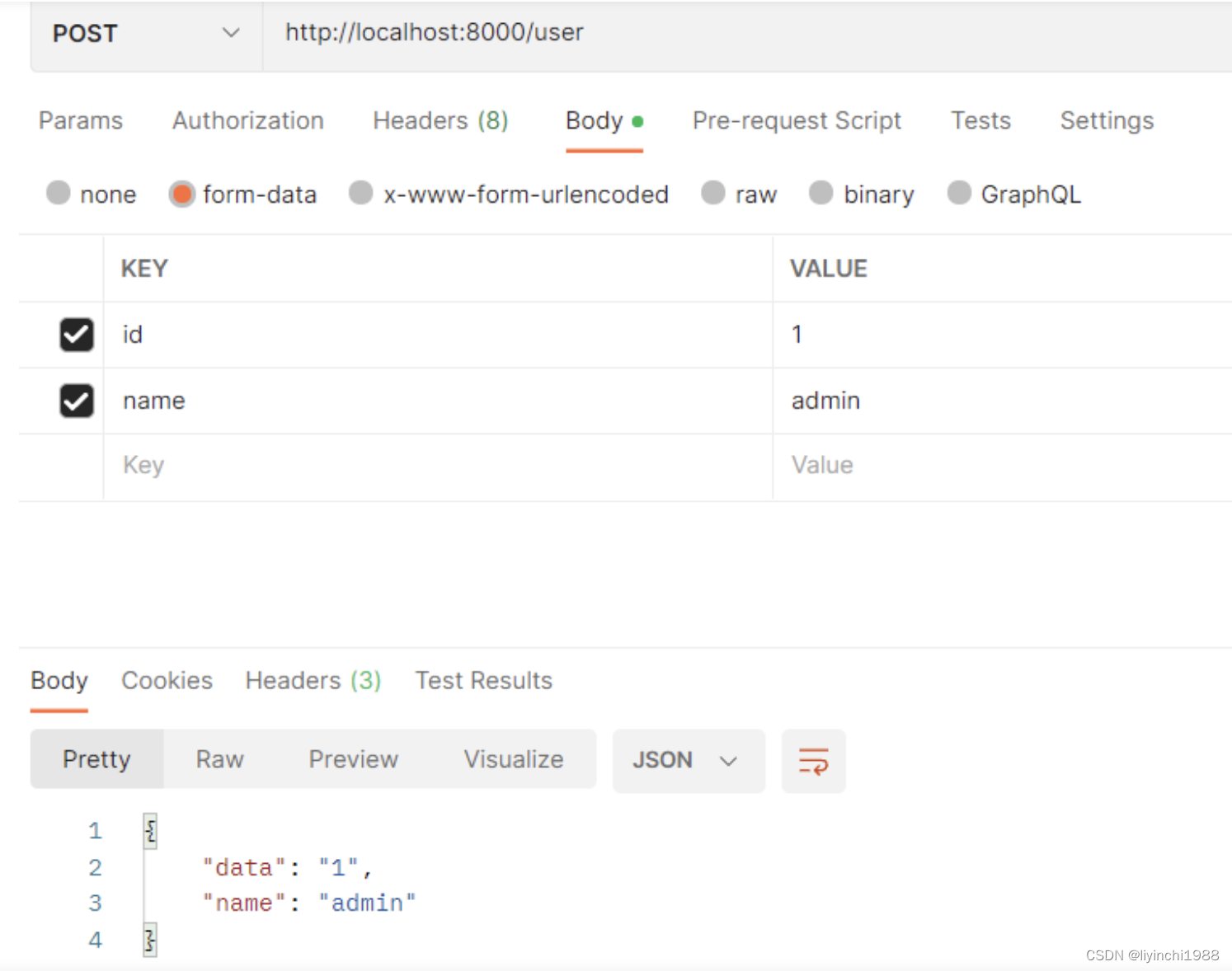
d、json参数
json参数测试与观察请求效果需要安装postman
通过Context的GetRawData或者ShouldBindJSON方法来获取表单参数
userApi.PUT("/:id", userUpdate)
userUpdate函数为
GetRawData方法
func userUpdate(ctx *gin.Context) {
b, err := ctx.GetRawData() // 从ctx.Request.Body读取请求数据
if err !=nil{
fmt.print(err)
}
// 定义map或结构体
var m map[string]interface{}
// 反序列化
_ = json.Unmarshal(b, &m)
ctx.JSON(http.StatusOK, gin.H{"data": m["id"], "name": m["name"]})
return
}
ShouldBindJSON方法
// 先定义结构
type User struct {
Id string `form:"id" json:"id" binding:"required"`
Name string `form:"name" json:"name" binding:"required"`
}
// 函数实现
func userUpdate(ctx *gin.Context) {
var user User
if err := ctx.ShouldBindJSON(&user); err == nil {
ctx.JSON(http.StatusOK, gin.H{"data": user.Id, "name": user.Name})
return
} else {
ctx.JSON(http.StatusOK, gin.H{"err": err.Error()})
return
}
}

e、参数绑定
为了能够更方便的获取请求相关参数,提高开发效率,我们可以基于请求的Content-Type识别请求数据类型并利用反射机制自动提取请求中form表单、JSON、XML等参数到结构体中。
代码示例:
定义要获取的结构
type User struct {
Id string `form:"id" json:"id" binding:"required"`
Name string `form:"name" json:"name" binding:"required"`
}
userCreate函数
func userCreate(ctx *gin.Context) {
// 实例化结构体对象
var user User
if err := ctx.ShouldBind(&user); err == nil {
// 响应体 json 格式
ctx.JSON(http.StatusOK, gin.H{"data": user.Id, "name": user.Name})
return
}else{
ctx.JSON(http.StatusOK, gin.H{"err": err.Error()})
return
}
}
userUpdate函数
func userUpdate(ctx *gin.Context) {
// 实例化结构体对象
var user User
if err := ctx.ShouldBind(&user); err == nil {
ctx.JSON(http.StatusOK, gin.H{"data": user.Id, "name": user.Name})
return
}else{
ctx.JSON(http.StatusOK, gin.H{"err": err.Error()})
return
}
}
3、上传文件
一般都是post请求表单传参
userApi.POST("/upload", userUpload)
userUpload函数
// 先定义结构
type FileUpload struct {
File *multipart.FileHeader `form:"file"`
Type string `form:"type"`
}
// 函数实现
func userUpload(ctx *gin.Context) {
var fileUpload FileUpload
//
if err := ctx.ShouldBind(&fileUpload); err == nil {
//获取运行路径
ex, err := os.Executable()
//
if err != nil {
ctx.JSON(http.StatusOK, gin.H{"err": err.Error()})
return
}
//定义接收文件的存放地址
path := filepath.Dir(ex) + string(os.PathSeparator) + fileUpload.File.Filename
//接收文件并保存到指定path
err = ctx.SaveUploadedFile(fileUpload.File, path)
ctx.JSON(http.StatusOK, gin.H{"data": path, "type": fileUpload.Type})
return
} else {
ctx.JSON(http.StatusOK, gin.H{"err": err.Error()})
return
}
}
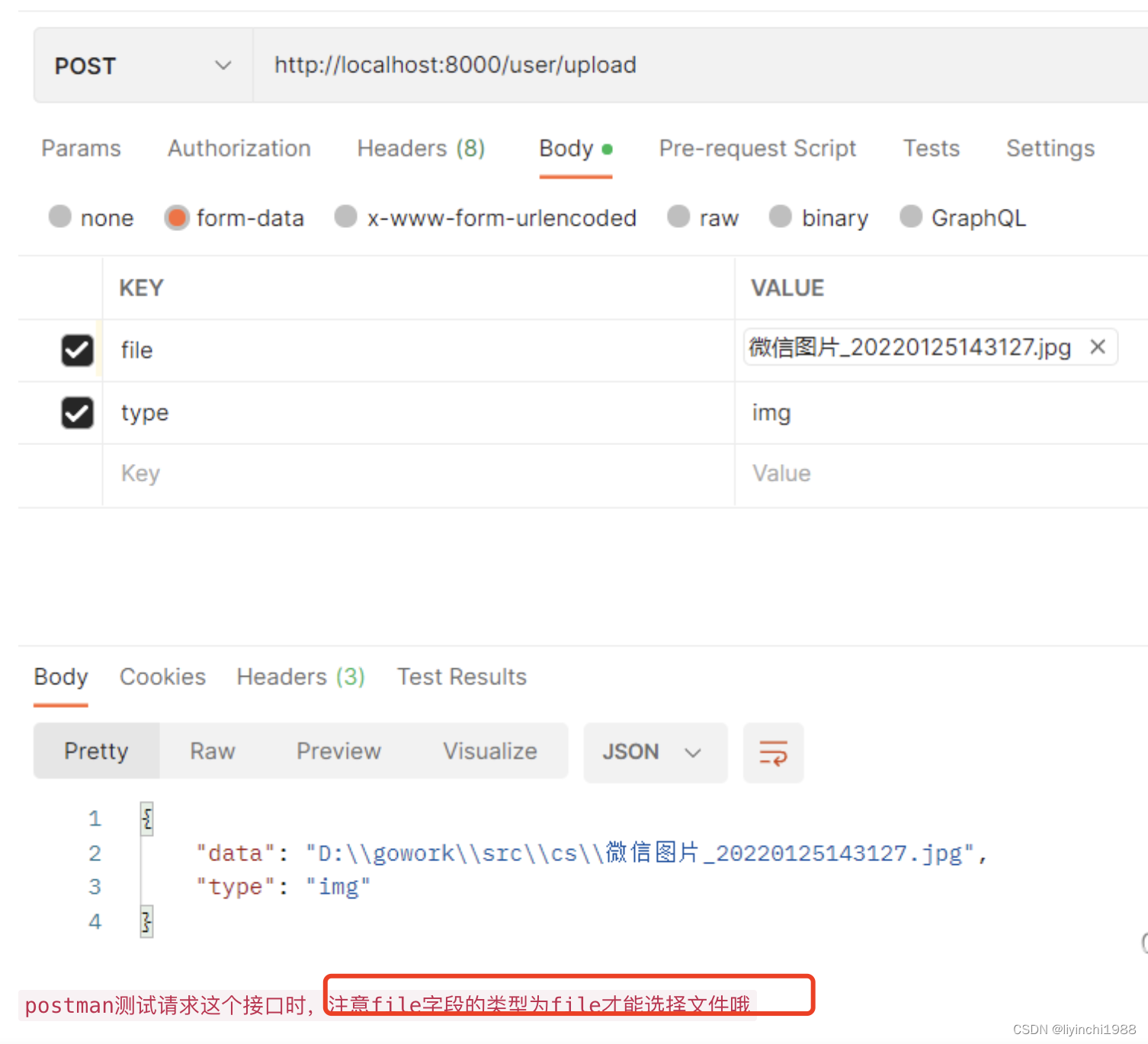
五、路由分组分文件
使用Gin框架写Go项目的时候,如果把路由都写在一个.go文件中,随着路由的数量的增加,会导致路由文件显得异常臃肿。
此时需要对路由进行分组并且分文件管理,更有利于代码的组织和维护
使用Gin框架写Go项目的时候,如果把路由都写在一个.go文件中,随着路由的数量的增加,会导致路由文件显得异常臃肿。
此时需要对路由进行分组并且分文件管理,更有利于代码的组织和维护
路由分组的实现
原始未分组的文件
func main() {
router := gin.Default()
router.POST("/one/a", OneAFunc)
router.POST("/one/b", OneBFunc)
router.POST("/one/c", OneCFunc)
router.POST("/one/d", OneDFunc)
router.POST("/one/e", OneEFunc)
router.POST("/one/f", OneFFunc)
router.POST("/one/g", OneGFunc)
router.POST("/one/h", OneHFunc)
router.POST("/one/i", OneIFunc)
/*
省略n条路由
*/
router.POST("/one/x", OneXFunc)
router.POST("/one/y", OneYFunc)
router.POST("/one/z", OneZFunc)
router.POST("/two/a", TwoAFunc)
router.POST("/two/b", TwoBFunc)
router.POST("/two/c", TwoCFunc)
router.POST("/two/d", TwoDFunc)
router.POST("/two/e", TwoEFunc)
router.POST("/two/f", TwoFFunc)
router.POST("/two/g", TwoGFunc)
router.POST("/two/h", TwoHFunc)
router.POST("/two/i", TwoIFunc)
/*
省略n条路由
*/
router.POST("/two/x", TwoXFunc)
router.POST("/two/y", TwoYFunc)
router.POST("/two/z", TwoZFunc)
router.Run(":8080")
}
路由逻辑分组
我们首先创建了一个路由组 one,它的前缀为 /one。
然后,使用了 POST 方法在路由组 one 中定义了多个路由处理函数 oneAFunc到oneZFunc,它们分别处理 /two/a到 /two/z 路由的 HTTP POST 请求
请求路径
/one/a/
/tow/a/
// 路由分组第一组
one := router.Group("/one")
{
one.POST("/a", OneAFunc)
one.POST("/b", OneBFunc)
one.POST("/c", OneCFunc)
one.POST("/d", OneDFunc)
one.POST("/e", OneEFunc)
one.POST("/f", OneFFunc)
one.POST("/g", OneGFunc)
one.POST("/h", OneHFunc)
one.POST("/i", OneIFunc)
/*
省略n条路由
*/
one.POST("/x", OneXFunc)
one.POST("/y", OneYFunc)
one.POST("/z", OneZFunc)
}
//路由分组第二组
two := router.Group("/two")
{
two.POST("/a", twoAFunc)
two.POST("/b", twoBFunc)
two.POST("/c", twoCFunc)
two.POST("/d", twoDFunc)
two.POST("/e", twoEFunc)
two.POST("/f", twoFFunc)
two.POST("/g", twoGFunc)
two.POST("/h", twoHFunc)
two.POST("/i", twoIFunc)
/*
省略n条路由
*/
two.POST("/x", twoXFunc)
two.POST("/y", twoYFunc)
two.POST("/z", twoZFunc)
}
分组后的go代码,虽然路由都实现路由分组,路由的逻辑显得清晰,但是路由文件还是集中在一个文件中,文件还是大。
路由分组后并分文件管理
文件结构
main.go
handlers/
├── one_handlers.go
└── two_handlers.go
main.go
import (
"github.com/gin-gonic/gin"
"your_project/routers"
)
func main() {
// 创建路由
router := gin.Default()
//
routers.SetupRouter(router)
// 路由分组第一组
routers.TwoRoutersInit(router)
// 路由分组第二组
routers.OneRoutersInit(router)
// 启动服务
router.Run(":8080")
}
TwoRoutersInit() 和 OneRoutersInit()对应下面两个文件:
one_handlers.go
package routers
import "github.com/gin-gonic/gin"
func OneRoutersInit(engine *gin.Engine) {
one := engine.Group("/one")
{
one.POST("/a", OneAFunc)
one.POST("/b", OneBFunc)
one.POST("/c", OneCFunc)
one.POST("/d", OneDFunc)
one.POST("/e", OneEFunc)
one.POST("/f", OneFFunc)
/*
省略n条路由
*/
one.POST("/x", OneXFunc)
one.POST("/y", OneYFunc)
one.POST("/z", OneZFunc)
}
}
func OneAFunc(context *gin.Context) {
}
/*
省略N多方法
*/
func OneZFunc(context *gin.Context) {
}
two_handlers.go
package routers
import "github.com/gin-gonic/gin"
func TwoRoutersInit(engine *gin.Engine) {
two := engine.Group("/two")
{
two.POST("/a", twoAFunc)
two.POST("/b", twoBFunc)
two.POST("/c", twoCFunc)
two.POST("/d", twoDFunc)
two.POST("/e", twoEFunc)
two.POST("/f", twoFFunc)
two.POST("/g", twoGFunc)
two.POST("/h", twoHFunc)
two.POST("/i", twoIFunc)
/*
省略n条路由
*/
two.POST("/x", twoXFunc)
two.POST("/y", twoYFunc)
two.POST("/z", twoZFunc)
}
}
func twoAFunc(context *gin.Context) {
}
/*
省略n多方法
*/
func twoZFunc(context *gin.Context) {
}
备注:每个路由都要放在{}中,每个路由对应的方法入参固定context *gin.Context 其中context风状态request和response
官方示例:
main.go
// main.go
package main
import (
"github.com/gin-gonic/gin"
"your_project/routers"
)
func main() {
r := gin.Default()
routers.SetupRouter(r)
r.Run() // listen and serve on 0.0.0.0:8080
}routers/router.go
package routers
import (
"github.com/gin-gonic/gin"
)
func SetupRouter(r *gin.Engine) {
v1 := r.Group("/v1")
{
v1.GET("/hello", func(c *gin.Context) {
c.JSON(200, gin.H{
"message": "hello",
})
})
}
v2 := r.Group("/v2")
{
v2.GET("/hello", func(c *gin.Context) {
c.JSON(200, gin.H{
"message": "hello v2",
})
})
}
}六、中间件
1、统一注册中间件
对全局路由或者已注册的路由组统一注册中间件
r.Use(CheckToken())
2、单独注册中间件
userApi.POST("/upload",CheckToken(),userUpload)
3、中间件函数实现
func CheckToken() gin.HandlerFunc {
return func(c *gin.Context) {
// 验证不通过直接跳出
//c.JSON(http.StatusBadRequest, gin.H{"msg": "need token"})
//c.Abort()
//return
// 验证通过继续
c.Next()
}
}
中间件场景
Go Gin JWT
https://blog.csdn.net/u013302168/article/details/132178429
七、vscode中如何使用go module导入包
go版本管理使用go module
(一)假设我们现在有moduleA和moduleB两个包
其中moduleA包中会导入moduleB包并使用它的New方法。
(注意:函数名称大写开头才能被引用)
moduleB/moduleB.go内容如下:
package moduleB
import "fmt"
func New(){
fmt.Println("moduleB.New")
}
1.分两种情况讨论:
(1)在同一个项目下
注意:在一个项目(project)下我们是可以定义多个包(package)的。
目录结构如下:
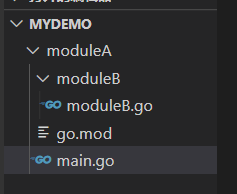
接着创建moduleA的mod,在集成终端中打开,并在命令行输入
go mod init moduleA 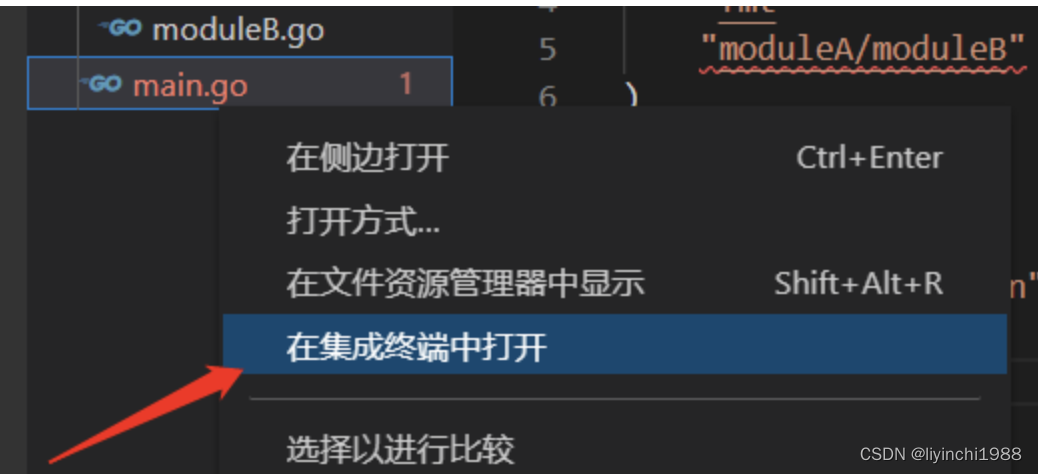

执行后,会在项目根目录下生成一个mod.go文件,执行go mod tidy 执行安装依赖 。
moduleA的go.mod内容如下:
module moduleA
go 1.17moudleA的main.go内容如下:
package main
import (
"fmt"
"moduleA/moduleB"
)
func main() {
moduleB.New()
fmt.Println("main")
}(2)在不同项目下执行
到这里完成了第一步,现在来到的第二步;
首先,将moduleB的代码拉出外面来,我们来实现不同项目下的包的引用
此时的moduleB的包(文件夹)里没有mod文件,所以需要自己mod init 。
打开终端,在命令行输入
go mod init moduleB此时moduleB的go.mod应该为:
module moduleA
go 1.17
require "moduleB" v0.0.0
replace "moduleB" => "../moduleB"
moduleB中的moduleB.go文件不动,和上面的一样
因为这两个包不在同一个项目路径下,你想要导入本地包,并且这些包也没有发布到远程的github或其他代码仓库地址。
这个时候我们就需要在go.mod文件中使用replace指令。
在调用方也就是moduleA/go.mod中按如下方式指定使用相对路径来寻找moduleB这个包。此时moduleA的go.mod文件应该为:
module moduleA
go 1.17
require "moduleB" v0.0.0
replace "moduleB" => "../moduleB"
moduleA的main.go文件应该为:
package main
import (
"fmt"
"moduleB"
)func main() {
moduleB.New()
fmt.Println("main")
}





















 1247
1247











 被折叠的 条评论
为什么被折叠?
被折叠的 条评论
为什么被折叠?










